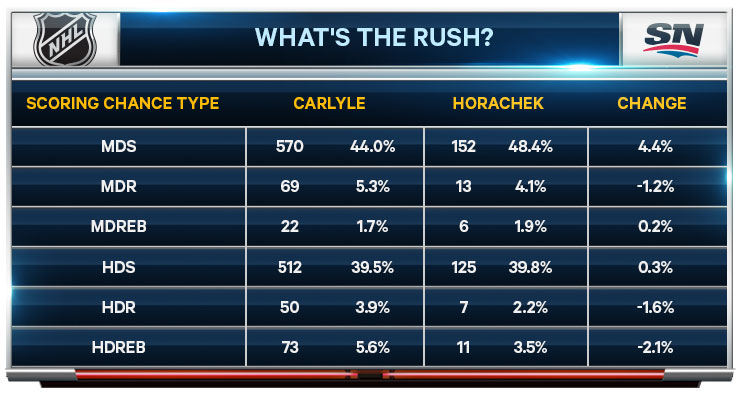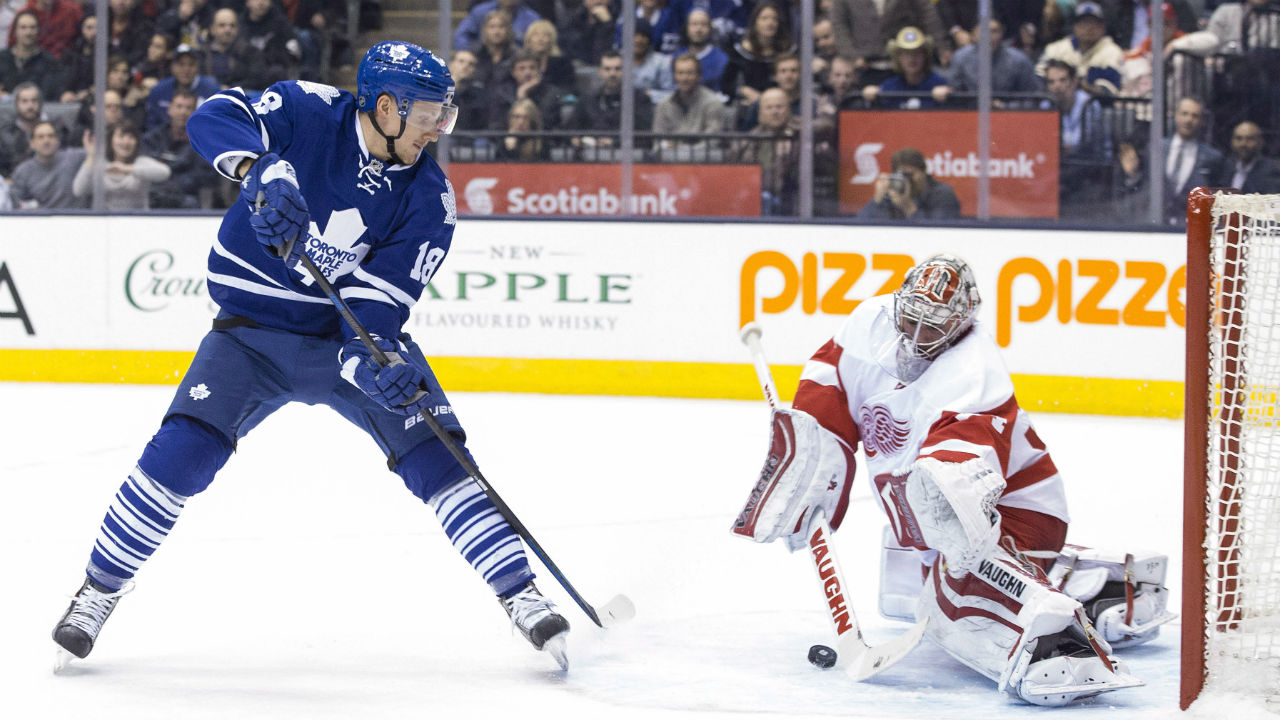The Toronto Maple Leafs have changed significantly under coach Peter Horachek. The top-scoring team in the league with Randy Carlyle manning the bench has suddenly tightened up while suffering through its lowest-scoring January history. The question on the minds of observers is: Can we blame Horachek for the dramatic decrease in offence?
To some extent, the underlying stats make a case that the Leafs should be seeing and increased likelihood of winning with their possession numbers having improved significantly. The shooting has dipped across the board and most players on the team have been scoring significantly less, but it the leading scorers have gone particularly dry.
 ATTENTION Rogers and Shaw customers.
ATTENTION Rogers and Shaw customers.
Already enjoying Sportsnet ONE? Now get access to digital editions of Sportsnet magazine at no extra cost.
Horachek has repeatedly insisted that his team will play a 5-5-5 system in all three zones—the forwards will provide defensive support and outlet options for pressured puck carriers, thus limiting offensive opportunities for the opposition and helping to maintain puck possession. Unfortunately for some of the Leafs more offensively gifted scorers, this means less flying the zone early for deep passes leading to rush shots.
The effects of the change can be seen quite starkly when comparing the scoring-chance generation rates for individual skaters under Carlyle versus under Horachek.

The most interesting comparison is the type of players generating more chances under Horachek. The Leafs’ most effective possession players this year (as measured by dCorsi) are Richard Panik, Daniel Winnik, Mike Santorelli, Leo Komarov, Jake Gardiner and Nazem Kadri. All six have produced scoring chances at higher rates since the switch to Horachek.
At the other end of the spectrum, there have been massive declines for Tyler Bozak, Phil Kessel and to a lesser extent Morgan Rielly and James van Riemsdyk. Those four have largely been generating shot attempts at the expense of more chances against in their own end. Defence had definitely been a secondary concern for that group prior to the coaching change.
Under Horachek, increased demands have been placed upon the entire team in terms of defensive responsibility and supporting the puck on breakouts. Many of the rush chances the JVR-Bozak-Kessel line had generated earlier in the season by flying the zone are drying up, particularly for Bozak and Kessel.
Another way to illustrate that is by breaking out scoring chances by type. Using data from war-on-ice.com we can differentiate between individual scoring chances for Leafs before and after the coaching change by danger levels based on location and type of chance. That allows an exploration of the mix of scoring chances under the new coach to see what shifts are taking place.
Below we can see that approximately 44 percent of Toronto’s scoring chances under Carlyle were medium-danger shots (MDS), four percent were high-danger rushes (HRS) and six percent were high-danger rebounds (HDReb)

Comparing those numbers to the (relatively brief) Horachek era, the changes are obvious. The Leafs are definitely generating a lower percentage of chances from HRS and HDRebs, with most of those chances shifting towards Med Shots. HRS and HDRebs are quite specifically the most likely to go in for goals. A rebound shot that requires a goaltender to shift laterally through a significant angle will result in a goal more 35 percent of the time, and that shooting percentage only increases as you get closer to the net into High Danger areas.
This data lends credence to the view that the current roster isn’t suited to play this style of more defensive hockey, though I would argue a more drastic shift is required than what the Leafs have shown thus far. In the 5-2 victory over Columbus, and the 1-0 loss to Los Angeles the Leafs briefly promoted Panik into the top six, rewarding him for some very solid play in recent weeks.
In those two games, Panik generated seven scoring chances in 35.8 minutes of ice time, which equates to an individual scoring chance rate (iSC60) of 11.73 scoring chances per 60 minutes. That is an elite rate, and it’s hard to believe they wouldn’t eventually start going in. His 9.86 iSC60 in all games Horachek has coached thus far ranks second on the Leafs, and would put him ahead of 90 percent of NHL forwards. He has been posting solid numbers all season and likely deserves more of a look in a top-six role. Clearing cap space is something the Leafs need to do, and letting younger players like Panik take a larger role makes sense given where things have been trending.
It should also be noted that the defensive emphasis is making a significant impact in another way: The vast majority of Leafs regulars have seen significant improvement in the percentage of scoring chances the team is generating while they are on the ice at even strength. While the scoring has slowed significantly, there are still many reasons for optimism in Leaf land, even if they’re hard to see from the bottom of the hole they’ve dug themselves.


